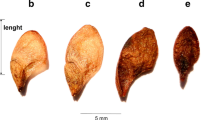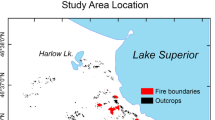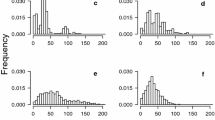Abstract
In temperate ecosystems, fire management involving prescribed burning and wildfire suppression often causes a shift in fire season from hot and dry summer conditions to cooler, moister conditions in spring or autumn. The effects of this change on seed dispersal by wind after fire are unknown. However, calmer wind conditions and increased standing vegetation after fires in cooler seasons may reduce seed dispersal following fire. We studied seed dispersal in different seasons for a serotinous obligate-seeder, Callitris verrucosa, growing in a semi-arid environment in South Australia. We measured primary (wind-borne) and secondary (on-ground) seed dispersal during spring, summer and autumn, using empirical observations and modelling based on detailed measurement of wind characteristics. At comparable horizontal wind speeds, primary dispersal was greater in summer compared to spring and autumn. Secondary dispersal was similarly short in all three seasons when vegetation cover was high, but when cover was low, seeds travelled much further in summer than in the other two seasons. A shift in the seasonal timing of seed release can decrease dispersal distances of serotinous obligate seeders, which is likely to reduce gene flow and the ability to colonise new sites. This can lead to changes in population and community structures which may further affect fire patterns. These findings could be applicable to other serotinous obligate seeding plant species found in other families such as Proteaceae, Myrtaceae, Pinaceae and Cupressaceae.





Similar content being viewed by others
Data accessibility
The data of this study have been published in AEKOS under the https://doi.org/10.4227/05/589007bda7528.
References
Adams R (1999) Germination of Callitris seeds in relation to temperature, water stress, priming, and hydration-dehydration cycles. J Arid Environ 43:437–448
Allen HD (2008) Fire: plant functional types and patch mosaic burning in fire-prone ecosystems. Prog Phys Geogr. https://doi.org/10.1177/0309133308096754
Banks SC, Cary GJ, Smith AL et al (2013) How does ecological disturbance influence genetic diversity? Trends Ecol Evol 28:670–679
Bennett A, Clarke M, Avitabile S, Brown L et al (2010) Fire and wildlife in the mallee: insights for conservation and management. LaTrobe University, Melbourne
Bohrer G, Nathan R, Volis S (2005) Effects of long distance dispersal for metapopulation survival and genetic structure at ecological time and spatial scales. J Ecol. https://doi.org/10.1111/j.1365-2745.2005.01048.x
Bond WJ, van Wilgen BW (1996) Fire and plants. Chapman & Hall, London
Bonney N, Miles A (1994) What seed is that?: a field guide to the identification, collection and germination of native seed in South Australia. Neville Bonney, Adelaide
Bowman DMJS, Balch JK, Artaxo P et al (2009) Fire in the earth system. Science 324:481–484
Bowman DMJS, Murphy BP, Burrows GE, Crisp MD (2012) Fire regimes and the evolution of the Australian biota. In: Bradstock RA, Williams RJ, Gill AM (eds) Flammable Australia: fire regimes, biodiversity and ecosystems in a changing world. CSIRO publishing, Clayton, pp 27–47
Bradstock RA, Bedward M, Scott J, Keith DA (1996) Simulation of the effect of spatial and temporal variation in fire regimes on the population viability of a Banksia species. Conserv Biol 10:776–784
Bradstock RA, Bedward M, Cohn JS (2006) The modelled effects of differing fire management strategies on the conifer Callitris verrucosa within semi-arid mallee vegetation in Australia. J Appl Ecol 43:281–292
Bradstock RA (2010) A biogeographic model of fire regimes in Australia: current and future implications. Glob Ecol Biogeogr. https://doi.org/10.1111/j.1466-8238.2009.00512.x
Bradstock RA, Auld TD (1995) Soil temperatures during experimental bushfires in relation to fire intensity: consequences for legume germination and fire management in south-eastern Australia. J Appl Ecol 32:76–84
Bradstock RA, Cohn JS (2002) Demographic characteristics of mallee pine (Callitris verrucosa) in fire-prone mallee communities of central New South Wales. Aust J Bot 50(5):653–665
Bullock JM, Clarke RT (2000) Long distance seed dispersal by wind: measuring and modelling the tail of the curve. Oecologia 124:506–521
Cain ML, Milligan BG, Strand AE (2000) Long-distance seed dispersal in plant populations. Am J Bot 87(9):1217–1227
Driscoll DA, Henderson MK (2008) How many common reptile species are fire specialists? A replicated natural experiment highlights the predictive weakness of a fire succession model. Biol Conserv 141(2):460–471
Enright NJ, Lamont BB (1989) Seed banks, fire season, safe sites and seedling recruitment in five co-occurring Banksia species. J Ecol 77:1111–1122
Foster BL, Tilman D (2003) Seed limitation and the regulation of community structure in oak savanna grassland. J Ecol 91(6):999–1007
Gavazzi MJ, McNulty SG (2014) The influence of prescribed fire and burn interval on fuel loads in four North Carolina forest ecosystems. In: Wade DD, Fox RL (eds) Proceedings of 4th Fire Behaviour and Fuels Conference, 18-22 February 2013, Raleigh, NC, USA. International Association of Wildland Fire, Missoula, Montana, USA, pp 26-48
Gill AM, Bradstock RA, Williams JE (2001) Fire regimes and biodiversity: legacy and vision. In: Bradstock RA, Williams JE, Gill MA (eds) Flammable Australia: the fire regimes and biodiversity on a continent. Cambridge University Press, Cambridge, pp 429–446
Hammill KA, Bradstock RA, Allaway WG (1998) Post-fire seed dispersal and species re-establishment in proteaceous heath. Aust J Bot 46(4):407–419
Harden GJ (1990) Flora of New South Wales. New South Wales University Press, Kensington
He T, Krauss SL, Lamont BB, Miller BP, Enright NJ (2004) Long distance seed dispersal in a metapopulation of Banksia hookeriana inferred from a population allocation analysis of amplified fragment length polymorphism data. Mol Ecol 13(5):1099–1109
Heidorn KC (2005) For strong winds: dry thunderstorms. www.islandnet.com/~see/weather/storm/drytstorm.htm
Hodgkinson KC (1991) Shrub recruitment response to intensity and season of fire in a semi-arid woodland. J Appl Ecol 28:60–70
Howe HF (1994) Response of early-and late-flowering plants to fire season in experimental prairies. Ecol Appl 4(1):121–133
Johnson EA, Miyanishi K (1995) The need for consideration of fire behavior and effects in prescribed burning. Restorat Ecol 3(4):271–278
Keeley JE, Zedler PH (2009) Large, high-intensity fire events in southern California shrublands: debunking the fine-grain age patch model. Ecol Appl 19:69–94
Keith DA, Williams JE, Woinarski JCZ (2002) Fire management and biodiversity conservation: key approaches and principles. In: Bradstock RA, Williams JE, Gill AM (eds) Flammable Australia: the fire regimes and biodiversity of a continent. Cambridge University Press, Cambridge, pp 401–425
Keith DA (2012) Functional traits: their roles in understanding and predicting biotic responses to fire regimes from individuals to landscapes. In: Bradstock RA, Williams JE, Gill AM (eds) Flammable Australia: fire regimes, biodiversity and ecosystems in a changing world. Cambridge University Press, Cambridge, pp 97–125
Knox KJE, Clarke PJ (2006) Fire season and intensity affect shrub recruitment in temperate sclerophyllous woodlands. Oecologia 149(4):730–739
Kuparinen A, Katul G, Nathan R, Schurr FM (2009) Increases in air temperature can promote wind-driven dispersal and spread of plants. Proc R Soc B 276(1670):3081–3087
Lamont BB, Le Maitre DC, Cowling RM, Enright NJ (1991) Canopy seed storage in woody plants. Bot Rev 57(4):277–317
Lamont BB, Witkowski ETF, Enright NJ (1993) Post-fire litter microsites: safe for seeds, unsafe for seedlings. Ecology 74(2):501–512
Levin DA, Kerster HW (1974) Gene flow in seed plants. In: Dobzhansky T, Hecht MK, Steere WC (eds) Evolutionary biology. Springer, Boston, pp 139–220
Lin X (1997) Variance component testing in generalised linear models with random effects. Biometrika 84(2):309–326
Loveless MD, Hamrick JL (1984) Ecological determinants of genetic structure in plant populations. Annu Rev Ecol Syst 15(1):65–95
Mackenzie BDE, Auld TD, Keith DA, Hui FKC, Ooi MKJ (2016) The effect of seasonal ambient temperatures on fire-stimulated germination of species with physiological dormancy: a case study using Boronia (Rutaceae). PLoS ONE. https://doi.org/10.1371/journal.pone.0156142
Meyn A, White PS, Buhk C, Jentsch A (2007) Environmental drivers of large, infrequent wildfires: the emerging conceptual model. Prog Phys Geogr. https://doi.org/10.1177/0309133307079365
Nathan R, Safriel UN, Noy-Meir I, Schiller G (1999) Seed release without fire in Pinus halepensis, a Mediterranean serotinous wind-dispersed tree. J Ecol 87:659–669
Nathan R, Safriel UN, Noy-Meir I (2001) Field validation and sensitivity analysis of a mechanistic model for tree seed dispersal by wind. Ecology 82(2):374–388
Nathan R (2005) Long distance dispersal research: building a network of yellow brick roads. Divers Distrib 11(2):125–130
Nathan R, Muller-Landau H (2000) Spatial patterns of seed dispersal, their determinants and consequences for recruitment. TREE 15(7):278–285
NatureMaps (2017) https://data.environment.sa.gov.au/NatureMaps/Pages/default.aspx
Oke AM, Tapper NJ, Dunkerley DL (2007) Willy-willies in the Australian landscape: the role of key meteorological variables and surface conditions in defining frequency and spatial characteristics. J Arid Environ 71(2):201–215
Pausas JG (2004) Changes in fire and climate in the eastern Iberian Peninsula (Mediterranean basin). Clim Change 63(3):337–350
Pausas JG, Bradstock RA, Keith DA, Keeley JE (2004) Plant functional traits in relation to fire in crown-fire ecosystems. Ecology 85(4):1085–1100
Pausas JG, Llovet J, Rodrigo A, Vallejo R (2009) Are wildfires a disaster in the Mediterranean basin?: a review. Int J Wildland Fire 17:713–723
Penman TD, Christie FJ, Andersen AN et al (2011) Prescribed burning: how can it work to conserve the things we value? Int J Wildland Fire 20(6):721–733
Prosser IP, Williams L (1998) The effect of wildfire on runoff and erosion in native Eucalyptus forest. Hydrol Processes 12(2):251–265
Pyne S (2010) The ecology of fire. Nature education knowledge 3(10):30. https://www.nature.com/scitable/knowledge/library/the-ecology-of-fire-13259892
R Development Core Team (2011) R: a language and environment for statistical computing. R Foundation for Statistical Computing, Vienna, Austria https://www.R-project.org
Schurr FM, Bond WJ, Midgley GF, Higgins SI (2005) A mechanistic model for secondary seed dispersal by wind and its experimental validation. J Ecol 93:1017–1028
Sheuyange A, Oba G, Weladji RB (2005) Effects of anthropogenic fire history on savanna vegetation in northeastern Namibia. J Environ Manage 75(3):189–198
Slijepcevic A, Tolhurst KG, Saunder G, Whight S, Marsden-Smedley J (2007) A prescribed burning risk assessment tool (BRAT). In: Proceedings Bushfire Cooperative Research Centre and Australasian Fire Authorities Council Annual Conference. Tassie Fire Conference, Wrest Point Conference Centre, Hobart, Tasmania
Smith AL (2012) Reptile dispersal and demography after fire: process-based knowledge to assist fire management for biodiversity. Dissertation, The Australian National University Canberra
Soons MB, Heil GW, Nathan R, Katul GG (2004) Determinants of long-distance seed dispersal by wind in grasslands. Ecology 85(11):3056–3068
Sullivan AL, McCaw WL, Cruz MG, Matthews S, Ellis PF (2012) Fuel, fire weather and fire behaviour in Australian ecosystems. In: Bradstock RA, Williams RJ, Gill AM (eds) Flammable Australia: fire regimes, biodiversity and ecosystems in a changing world. CSIRO Publishing, Collingwoo, p 51
Tackenberg O (2003) Modeling long-distance dispersal of plant diaspores by wind. Ecol Monogr 73(2):173–189
Tackenberg O, Poschlod P, Bonn S (2003) Assessment of wind dispersal potential in plant species. Ecol Monogr 73(2):191–205
Tackenberg O, Poschlod P, Kahmen S (2003) Dandelion seed dispersal: the horizontal wind speed does not matter for long-distance dispersal - it is updraft! Plant Biol 5(5):451–454
Thomas PB, Morris EC, Auld TD, Haigh AM (2010) The interaction of temperature, water availability and fire cues regulates seed germination in a fire-prone landscape. Oecologia 162(2):293–302
Trakhtenbrot A, Nathan R, Perry G, Richardson DM (2005) The importance of long-distance dispersal in biodiversity conservation. Divers Distrib 11(2):173–181
Van Wilgen BW, Forsyth GG, De Klerk H, Das S, Khuluse S, Schmitz P (2010) Fire management in Mediterranean climate shrublands: a case study from the Cape fynbos. South Africa. J Appl Ecol 47(3):631–638
Wilson JB, Agnew ADQ (1992) Positive-feedback switches in plant communities. Adv Ecol Res 23:263–336
Wright SJ, Trakhtenbrot A, Bohrer G, Detto M, Katul GG, Horvitz N, Muller-Landau HC, Jones FA, Nathan R (2008) Understanding strategies for seed dispersal by wind under contrasting atmospheric conditions. PNAS 105(49):19084–19089
Zimmer H, Green P, Cheal D, Clarke MF (2011) Reconstructing Mallee fire history using Callitris verrucosa tree rings, Arthur Rylah Institute for Environmental Research Technical Report Series No. 215. Department of Sustainability and Environment, Heidelberg, Victoria
Acknowledgements
The field work was carried out under research permits from the Department of Environment, Water and Natural Resources (A25784-2 and A25784-3) and completed with the help of many volunteers. Oliver Tackenberg provided access to PAPPUS software and assisted with its application together with Felix Heydel. Dale Burzacott provided valuable help with field gear, and Joe Tilley, Department of Environment, Water and Natural Resources, Pt. Lincoln, provided logistical support in the field, and Pawel Skuza provided statistical advice.
Funding
This study was funded by the Australian Research Council (ARC), SA Native Vegetation Council, Department of Environment, Water and Natural Resources (DEWNR), NSW Office of Environment and Heritage and the Nature Foundation of SA.
Author information
Authors and Affiliations
Corresponding author
Additional information
Communicated by E.T.F Witkowski.
Publisher's Note
Springer Nature remains neutral with regard to jurisdictional claims in published maps and institutional affiliations.
Rights and permissions
About this article
Cite this article
Dunker, B., Bull, C.M., Keith, D.A. et al. Season of fire influences seed dispersal by wind in a serotinous obligate seeding tree. Plant Ecol 220, 405–416 (2019). https://doi.org/10.1007/s11258-019-00923-2
Received:
Accepted:
Published:
Issue Date:
DOI: https://doi.org/10.1007/s11258-019-00923-2




